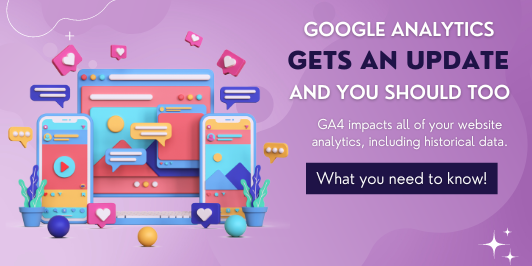If you haven’t heard, Google Analytics 4 (GA4) will launch in the summer of 2023. It’s a big change. So big, in fact, Universal Analytics (UA) will go away.
Why should I worry about this now?
Google says, “All standard Universal Analytics properties will stop processing new hits on July 1, 2023. 360 Universal Analytics (UA) properties will stop processing new hits on October 1, 2023.”
So, why switch now and not wait until 2023? Simple, data continuity.
Once the switch is forced, data captured by Universal Analytics code will no longer be available. That means you won’t be able to view data prior to the forced replacement.
Let’s say you have had a UA property that’s been tracking your website and AdWords accounts for years. If you do not make the shift in 2022, that data will no longer be available once the forced shift happens.
If you do make the transition to GA4, you have the option to run the data side-by-side for the period in which you launch, giving you historic data to download prior to losing it in 2023.
What’s the difference between UA and GA4?
First, GA4 uses a new architecture built around event concepts, versus pageviews like UA use. Events are things like pageviews, clicks, form submissions, and custom events you track. Google provides a side-by-side comparison here.
That means you get:
- In-depth insights into what people are doing on your site
- More data than before
- Tracking capabilities for just about anything, not just website traffic
- Cross-platform user tracking across devices and platforms
- Enhanced data stream views to view data based on criteria you choose, e.g., app traffic, country-specific data
- Enriched conversion tracking and ability to see the entire user journey from start to finish
What’s new?
The interface and terminology are different, which may feel complicated and clunky – another reason to start learning about this now. Here are five things to look at once you’ve turned on the GA4.
- Reporting will be very different – both in location and look/feel. If you have custom reports, they will have to be recreated.
- GA4 does not support filters. If you’ve used them on your UA account, they will go buh-bye.
- Bounce rate will also go away in GA4. Instead, you’ll have engaged user metrics to determine if people like what they find on your site. To manage this, adjust the Data Stream > More Tagging settings length of time from the default 10 seconds up to 60 seconds.
- Events (actions people take on your sites like clicks, video play, and downloads) are automatically tracked without setting up additional event racking measures manually.
- There are five, pre-defined conversions automatically tracked. If you already have goals on the existing account, you can migrate them to GA4 using the Goals Migration Tool. It is limited to 30 custom events, such as download, on-click, form-submissions, purchase, and contact_us.
What do I need to do now?
If you manage your own Google Analytics account, the time is now to start the GA4 process. If you have someone supporting your website, reach out to them and ask them to begin the implementation process.
Tip: If you’re using WordPress, the HT Easy G4 plugin provides the header coded for the site so you don’t have to touch the theme header.php code.
Avoid waiting until the last minute to implement this so your data isn’t lost.

